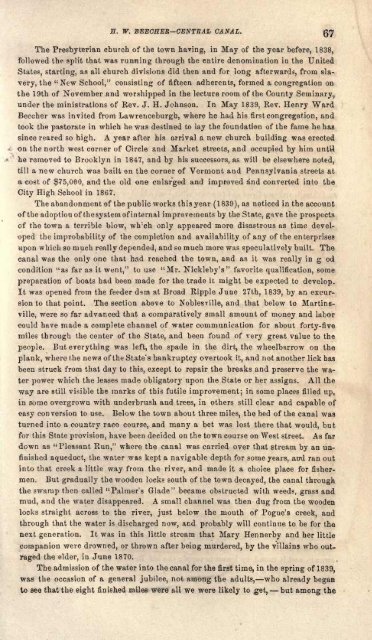Indianapolis- a historical and statistical sketch, 1870,WR Holloway
Indianapolis- a historical and statistical sketch, 1870,WR Holloway
Indianapolis- a historical and statistical sketch, 1870,WR Holloway
Create successful ePaper yourself
Turn your PDF publications into a flip-book with our unique Google optimized e-Paper software.
H. W. BEECHES CENTRAL CANAL. 67<br />
The Presbyterian church of the town having, in May of the year before, 1838,<br />
followed the split that was running through the entire denomination in the United<br />
States, starting, as all church divisions did then <strong>and</strong> for long afterwards, from sla-<br />
very, the "New School," consisting of fifteen adherents, formed a congregation on<br />
the 19th of November <strong>and</strong> worshipped in the lecture room of the County Seminary.,<br />
under the ministrations of Rev. J. H. Johnson. In May 1839, Rev. Henry Ward<br />
Beecher was invited from Lawrenceburgh, where he had his first congregation, <strong>and</strong><br />
took the pastorate in which he was destined to lay the foundation of the fame he has<br />
since reared so high. A year after his arrival a new church building was erected<br />
on the north west corner of Circle <strong>and</strong> Market streets, <strong>and</strong> occupied by him until<br />
he removed to Brooklyn in 1847, <strong>and</strong> by his successors, as will be elsewhere noted,<br />
till a new church was built on the corner of Vermont <strong>and</strong> Pennsylvania streets at<br />
a cost of $75,000, <strong>and</strong> the old one enlarged <strong>and</strong> improved <strong>and</strong> converted into the<br />
City High School in 1867.<br />
The ab<strong>and</strong>onment of the public works this year (1839),<br />
as noticed in the account<br />
of the adoption of thesystem of internal improvements by the State, g>ive the prospects<br />
;<br />
of the town a terrible blow, wh ch only appeared more disastrous as time devel-<br />
oped the improbability of the completion <strong>and</strong> availability of any of the enterprises<br />
upon which so much really depended, <strong>and</strong> so much more was speculatively built. The<br />
canal was the only one that had reached the town, <strong>and</strong> as it was really in g od<br />
condition "as far as it went," to use "Mr. Nickleby's" favorite qualification, some<br />
preparation of boats had been made for the trade it might be expected to develop.<br />
It was opened from the feeder dam at Broad Ripple June 27th, 1839, by an excur-<br />
sion to that point. The section above to Noblesrille, <strong>and</strong> that below to Martins-<br />
ville, were so far advanced that a comparatively small amount of money <strong>and</strong> labor<br />
could have made a complete channel of water communication for about forty-five<br />
miles through the center of the State, <strong>and</strong> been found of very great value to the<br />
people. But everything was left, the spade in the dirt, the wheelbarrow on the<br />
plank, where the news of the State's bankruptcy overtook it, <strong>and</strong> not another lick has<br />
been struck from that day to this, except to repair the breaks <strong>and</strong> preserve the wa-<br />
ter power which the leases made obligator}' upon the State or her assigns.<br />
All the<br />
way are still visible the marks of this futile improvement; in some places filled up,<br />
in some overgrown with underbrush <strong>and</strong> trees, in others still clear <strong>and</strong> capable of<br />
easy conversion to use. Below the town about three miles, the bed of the canal was<br />
turned into a country race course, <strong>and</strong> many a bet was lost there that would, but<br />
for this State provision, have been decided on the town course on West street. As far<br />
down as "Pleasant Run," where the canal was carried over that stream by an unfinished<br />
aqueduct, the water was kept a navigable depth for some years, aird ran out<br />
into that creek a little way from the river, <strong>and</strong> made it a choice place for fisher-<br />
men. But gradually the wooden locks south of the town decayed, the canal through<br />
the swamp then called "Palmer's Glade" became obstructed with weeds, grass <strong>and</strong><br />
mud, <strong>and</strong> the water disappeared. A small channel was then dug from the wooden<br />
locks straight across to the river, just below the mouth of Pogue's creek, <strong>and</strong><br />
through that the water is discharged now, <strong>and</strong> probably will continue to be for the<br />
next generation. It was in this little stream that Mary Hennerby <strong>and</strong> her little<br />
companion were drowned, or thrown after being murdered, by the villains who outraged<br />
the elder, in June <strong>1870</strong>.<br />
The admission of the water into the canal for the first time, in the spring of 1839,<br />
was the occasion of a general jubilee, not among the adults, who already began<br />
to see that the eight finished milea were all we were likely to get, but among the


